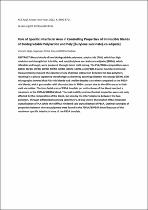 ResearchSpace
ResearchSpace
Role of special interfacial area in controlling properties of immiscible blends of biodegradable polylactide and poly[(butylene succinate)-co-adipate
JavaScript is disabled for your browser. Some features of this site may not work without it.
- ResearchSpace
- →
- Research Publications/Outputs
- →
- Journal Articles
- →
- View Item
| dc.contributor.author |
Ojijo, Vincent O

|
|
| dc.contributor.author |
Ray, Suprakas S

|
|
| dc.contributor.author |
Sadiku, R

|
|
| dc.date.accessioned | 2013-01-28T08:48:16Z | |
| dc.date.available | 2013-01-28T08:48:16Z | |
| dc.date.issued | 2012-12 | |
| dc.identifier.citation | Ojijo, V., Ray, S.S. and Sadiku, R. 2012. Role of special interfacial area in controlling properties of immiscible blends of biodegradable polylactide and poly[(butylene succinate)-co-adipate. ACS Applied Materials and Interfaces, vol. 4(12), pp. 6690-6701 | en_US |
| dc.identifier.issn | 1944-8244 | |
| dc.identifier.uri | http://pubs.acs.org/doi/abs/10.1021/am301842e | |
| dc.identifier.uri | http://hdl.handle.net/10204/6474 | |
| dc.description | Copyright: 2012 ACS Publications. This is an ABSTRACT ONLY. | en_US |
| dc.description.abstract | Binary blends of two biodegradable polymers: polylactide (PLA), which has high modulus and strength but is brittle, and poly[(butylene succinate)-co-adipate] (PBSA), which is flexible and tough, were prepared through batch melt mixing. The PLA/PBSA compositions were 100/0, 90/10, 70/ 30, 60/40, 50/50, 40/60, 30/70, 10/90, and 0/100. Fouriertransform infrared measurements revealed the absence of any chemical interaction between the two polymers, resulting in a phase-separated morphology as shown by scanning electron microscopy (SEM). SEM micrographs showed that PLA-rich blends had smaller droplet sizes when compared to the PBSArich blends, which got smaller with the reduction in PBSA content due to the differences in their melt viscosities. The interfacial area of PBSA droplets per unit volume of the blend reached a maximum in the 70PLA/30PBSA blend. Thermal stability and mechanical properties were not only affected by the composition of the blend, but also by the interfacial area between the two polymers. Through differential scanning calorimetry, it was shown that molten PBSA enhanced crystallization of PLA while the stiff PLA hindered cold crystallization of PBSA. Optimal synergies of properties between the two polymers were found in the 70PLA/30PBSA blend because of the maximum specific interfacial area of the PBSA droplets. | en_US |
| dc.language.iso | en | en_US |
| dc.publisher | ACS Publications | en_US |
| dc.relation.ispartofseries | Workflow;10124 | |
| dc.subject | Phase morphology | en_US |
| dc.subject | Polylactide/poly[(butylene succinate)-co-adipate] blends | en_US |
| dc.subject | Polymer blends | en_US |
| dc.subject | Biodegradable polymers | en_US |
| dc.title | Role of special interfacial area in controlling properties of immiscible blends of biodegradable polylactide and poly[(butylene succinate)-co-adipate | en_US |
| dc.type | Article | en_US |
| dc.identifier.apacitation | Ojijo, V. O., Ray, S. S., & Sadiku, R. (2012). Role of special interfacial area in controlling properties of immiscible blends of biodegradable polylactide and poly[(butylene succinate)-co-adipate. http://hdl.handle.net/10204/6474 | en_ZA |
| dc.identifier.chicagocitation | Ojijo, Vincent O, Suprakas S Ray, and R Sadiku "Role of special interfacial area in controlling properties of immiscible blends of biodegradable polylactide and poly[(butylene succinate)-co-adipate." (2012) http://hdl.handle.net/10204/6474 | en_ZA |
| dc.identifier.vancouvercitation | Ojijo VO, Ray SS, Sadiku R. Role of special interfacial area in controlling properties of immiscible blends of biodegradable polylactide and poly[(butylene succinate)-co-adipate. 2012; http://hdl.handle.net/10204/6474. | en_ZA |
| dc.identifier.ris | TY - Article AU - Ojijo, Vincent O AU - Ray, Suprakas S AU - Sadiku, R AB - Binary blends of two biodegradable polymers: polylactide (PLA), which has high modulus and strength but is brittle, and poly[(butylene succinate)-co-adipate] (PBSA), which is flexible and tough, were prepared through batch melt mixing. The PLA/PBSA compositions were 100/0, 90/10, 70/ 30, 60/40, 50/50, 40/60, 30/70, 10/90, and 0/100. Fouriertransform infrared measurements revealed the absence of any chemical interaction between the two polymers, resulting in a phase-separated morphology as shown by scanning electron microscopy (SEM). SEM micrographs showed that PLA-rich blends had smaller droplet sizes when compared to the PBSArich blends, which got smaller with the reduction in PBSA content due to the differences in their melt viscosities. The interfacial area of PBSA droplets per unit volume of the blend reached a maximum in the 70PLA/30PBSA blend. Thermal stability and mechanical properties were not only affected by the composition of the blend, but also by the interfacial area between the two polymers. Through differential scanning calorimetry, it was shown that molten PBSA enhanced crystallization of PLA while the stiff PLA hindered cold crystallization of PBSA. Optimal synergies of properties between the two polymers were found in the 70PLA/30PBSA blend because of the maximum specific interfacial area of the PBSA droplets. DA - 2012-12 DB - ResearchSpace DP - CSIR KW - Phase morphology KW - Polylactide/poly[(butylene succinate)-co-adipate] blends KW - Polymer blends KW - Biodegradable polymers LK - https://researchspace.csir.co.za PY - 2012 SM - 1944-8244 T1 - Role of special interfacial area in controlling properties of immiscible blends of biodegradable polylactide and poly[(butylene succinate)-co-adipate TI - Role of special interfacial area in controlling properties of immiscible blends of biodegradable polylactide and poly[(butylene succinate)-co-adipate UR - http://hdl.handle.net/10204/6474 ER - | en_ZA |





